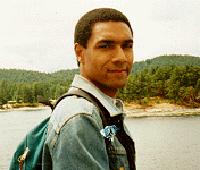
Assistant Professor of Chemistry, Mount Holyoke College
Email: sdecatur@mhc.mtholyoke.edu
S. Decatur Chemistry Department Web Site
Ph.D.: Stanford University
Biochemistry of Nitrosylhemes and Vibrational Studies of Helical Peptides
Currently our group’s work is focused on two different areas: nitric oxide regulation of heme proteins and dissecting the amide I modes of helical peptides. Our first area of interest is the chemistry behind the biological activities of nitric oxide (NO). Although it is a toxic free radical gas, NO is generated in vivo by a variety of mammalian tissues and serves as an intercellular messenger in neurotransmission and vasodilation. An important protein in NO’s biological activity is guanylate cyclase, which catalyzes the conversion of GTP to cGMP when activated by NO. The binding of NO to heme is an important step in the activation of guanylate cyclase. We are currently studying the structural properties of nitrosylheme complexes, using model heme systems and model heme proteins (such as mutants of sperm whale myoglobin). The long-term goal of this project is to apply the information from studies of simple models to characterize the fundamental chemistry behind NO activation of guanylate cyclase.
Our second area of interest concerns protein structure and folding. In a protein, the transition dipoles of the amide I vibrations of the peptide groups are coupled to each other, resulting in vibrational modes which are delocalized over large stretches of the polypeptide backbone. This transition dipole coupling results in an FTIR spectrum which is sensitive to the overall secondary structure of the polypeptide. However, these spectra lack specific local structural information about the polypeptide. One approach to this problem is to introduce 13C labeled residues within the peptide’s sequence. This isotopic label causes that particular amino acid to vibrate at a frequency slightly different from that of the rest of the peptide. Currently, the group’s effort is directed towards probing the structure and dynamics of model alpha helices using this technique. The long-term goal of this project is to develop methodology for incorporating site-specific infrared probes in proteins to be used as monitors of structural changes during folding and/or functional events.
Representative publications:
Decatur, S.M., Franzen, S., DePillis, G.D., Dyer, R.B., Woodruff, W. and Boxer, S.G. (1996) Trans effects in nitric oxide binding to myoglobin cavity mutant H93G. Biochemistry 35, 4934-4939.
Decatur, S.M., DePillis, G.D. and Boxer, S.G. (1996) Modulation of protein function by exogenous ligands in protein cavities: CO binding to a myoglobin cavity mutant containing unnatural proximal ligands. Biochemistry 35, 3925-3932.
Decatur, S.M. and Boxer, S.G. (1995) A test of the role of electrostatic interactions in determining the CO stretch frequency in carbonmonoxmyoglobin. Biochemical and Biophysical Research Communications 212, 159-164.
Decatur, S.M. and Boxer, S.G. (1994) 1H NMR characterization of myoglobins where exogenous imidazoles replace the proximal histidine. Biochemistry 34, 2122-2129.